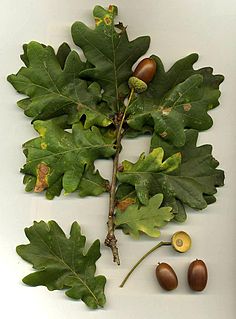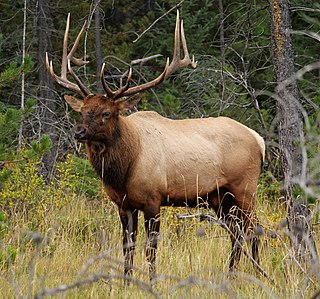Related Research Articles

Carnivora is an order of placental mammals that have specialized in primarily eating flesh. Its members are formally referred to as carnivorans, though some species are omnivorous, such as raccoons and bears, and quite a few species such as pandas are specialized herbivores. The word "carnivore" is derived from Latin carō "flesh" and vorāre "to devour" and refers to any meat-eating organism. The order Carnivora is the fifth largest order of mammals and one of the more successful members of the group, as it comprises at least 279 species.

The killer whale, also known as the orca, is a toothed whale belonging to the oceanic dolphin family, of which it is the largest member. Killer whales have a diverse diet, although individual populations often specialize in particular types of prey. Some feed exclusively on fish, while others hunt marine mammals such as seals and other species of dolphin. They have been known to attack baleen whale calves, and even adult whales. Killer whales are apex predators, as no animal preys on them. A cosmopolitan species, they can be found in each of the world's oceans in a variety of marine environments, from Arctic and Antarctic regions to tropical seas, absent only from the Baltic and Black seas, and some areas of the Arctic Ocean.

A lynx is any of the four species within the medium-sized wild cat genus Lynx. The name lynx originated in Middle English via Latin from the Greek word λύγξ, derived from the Indo-European root leuk- in reference to the luminescence of its reflective eyes.

Squirrels are members of the family Sciuridae, a family that includes small or medium-size rodents. The squirrel family includes tree squirrels, ground squirrels, chipmunks, marmots, flying squirrels, and prairie dogs amongst other rodents. Squirrels are indigenous to the Americas, Eurasia, and Africa, and were introduced by humans to Australia. The earliest known fossilized squirrels date from the Eocene epoch, and among other living rodent families, the squirrels are most closely related to the mountain beaver and to the dormice.

Scorpions are predatory arachnids of the order Scorpiones. They have eight legs, and are easily recognized by a pair of grasping pincers and a narrow, segmented tail, often carried in a characteristic forward curve over the back and always ending with a stinger. The evolutionary history of scorpions goes back 435 million years. They mainly live in deserts but have adapted to a wide range of environmental conditions, and can be found on all continents except Antarctica. There are over 2,500 described species, with 22 extant (living) families recognized to date. Their taxonomy is being revised to account for 21st-century genomic studies.

An oak is a tree or shrub in the genus Quercus of the beech family, Fagaceae. There are approximately 500 extant species of oaks. The common name "oak" also appears in the names of species in related genera, notably Lithocarpus, as well as in those of unrelated species such as Grevillea robusta and the Casuarinaceae (she-oaks). The genus Quercus is native to the Northern Hemisphere, and includes deciduous and evergreen species extending from cool temperate to tropical latitudes in the Americas, Asia, Europe, and North Africa. North America contains the largest number of oak species, with approximately 90 occurring in the United States, while Mexico has 160 species of which 109 are endemic. The second greatest center of oak diversity is China, which contains approximately 100 species.

Sharks are a group of elasmobranch fish characterized by a cartilaginous skeleton, five to seven gill slits on the sides of the head, and pectoral fins that are not fused to the head. Modern sharks are classified within the clade Selachimorpha and are the sister group to the rays. However, the term "shark" has also been used for extinct members of the subclass Elasmobranchii outside the Selachimorpha, such as Cladoselache and Xenacanthus, as well as other Chondrichthyes such as the holocephalid eugenedontidans.

Biodiversity is the biological variety and variability of life on Earth. Biodiversity is typically a measure of variation at the genetic, species, and ecosystem level. Terrestrial biodiversity is usually greater near the equator, which is the result of the warm climate and high primary productivity. Biodiversity is not distributed evenly on Earth, and is richer in the tropics. These tropical forest ecosystems cover less than 10 percent of earth's surface, and contain about 90 percent of the world's species. Marine biodiversity is usually higher along coasts in the Western Pacific, where sea surface temperature is highest, and in the mid-latitudinal band in all oceans. There are latitudinal gradients in species diversity. Biodiversity generally tends to cluster in hotspots, and has been increasing through time, but will be likely to slow in the future as a primary result of deforestation.

A tuna is a saltwater fish that belongs to the tribe Thunnini, a subgrouping of the Scombridae (mackerel) family. The Thunnini comprise 15 species across five genera, the sizes of which vary greatly, ranging from the bullet tuna up to the Atlantic bluefin tuna. The Atlantic bluefin averages 2 m (6.6 ft), and is believed to live up to 50 years.

Extinction is the termination of a kind of organism or of a group of kinds (taxon), usually a species. The moment of extinction is generally considered to be the death of the last individual of the species, although the capacity to breed and recover may have been lost before this point. Because a species' potential range may be very large, determining this moment is difficult, and is usually done retrospectively. This difficulty leads to phenomena such as Lazarus taxa, where a species presumed extinct abruptly "reappears" after a period of apparent absence.

Herring are forage fish, mostly belonging to the family Clupeidae.

Emydidae is a family of testudines (turtles) that includes close to 50 species in 10 genera. Members of this family are commonly called terrapins, pond turtles, or marsh turtles. Several species of Asian box turtles were formerly classified in the family; however, revised taxonomy has separated them to a different family (Geoemydidae). As currently defined, the Emydidae are entirely a Western Hemisphere family, with the exception of two species of pond turtle.

Endemism is the state of a species being native to a single defined geographic location, such as an island, state, nation, country or other defined zone; organisms that are indigenous to a place are not endemic to it if they are also found elsewhere. For example, the Cape sugarbird is exclusively found in southwestern South Africa and is therefore said to be endemic to that particular part of the world. The extreme opposite of an endemic species is one with a cosmopolitan distribution, having a global or widespread range.

A flower, sometimes known as a bloom or blossom, is the reproductive structure found in flowering plants. The biological function of a flower is to facilitate reproduction, usually by providing a mechanism for the union of sperm with eggs. Flowers may facilitate outcrossing resulting from cross pollination or allow selfing when self pollination occurs.

The elk or wapiti is one of the largest species within the deer family, Cervidae, and one of the largest terrestrial mammals in North America, as well as Central and Northeast Asia. It is not to be confused with the still larger moose of North America, alternatively known as "elk" in British English and related names in other European languages, in reference to populations in Eurasia. Elk range in forest and forest-edge habitat, feeding on grasses, plants, leaves, and bark. Male elk have large antlers which they shed each year. Males also engage in ritualized mating behaviors during the rut, including posturing, antler wrestling (sparring), and bugling, a loud series of vocalizations that establishes dominance over other males and attracts females.

Pseudothelphusidae is a family of freshwater crabs found chiefly in mountain streams in the Neotropics. They are believed to have originated in the Greater Antilles and then crossed to Central America via a Pliocene land bridge.

Coccinellidae is a widespread family of small beetles ranging in size from 0.8 to 18 mm. The family is commonly known as ladybugs in North America and ladybirds in Britain and other parts of the English-speaking world. Entomologists prefer the names ladybird beetles or lady beetles as these insects are not classified as true bugs.
In biology, a species is the basic unit of classification and a taxonomic rank of an organism, as well as a unit of biodiversity. A species is often defined as the largest group of organisms in which any two individuals of the appropriate sexes or mating types can produce fertile offspring, typically by sexual reproduction. Other ways of defining species include their karyotype, DNA sequence, morphology, behaviour or ecological niche. In addition, paleontologists use the concept of the chronospecies since fossil reproduction cannot be examined.
The Plant List is a list of botanical names of species of plants created by the Royal Botanic Gardens, Kew and the Missouri Botanical Garden and launched in 2010. It was intended to be a comprehensive record of all known names of plant species over time, and was produced in response to Target 1 of the 2002-2010 Global Strategy for Plant Conservation, to produce "An online flora of all known plants.” It has not been updated since 2013, and is superseded by World Flora Online.

Shrimp are decapod crustaceans with elongated bodies and a primarily swimming mode of locomotion – most commonly Caridea and Dendrobranchiata. More narrow definitions may be restricted to Caridea, to smaller species of either group or to only the marine species. Under a broader definition, shrimp may be synonymous with prawn, covering stalk-eyed swimming crustaceans with long narrow muscular tails (abdomens), long whiskers (antennae), and slender legs. Any small crustacean which resembles a shrimp tends to be called one. They swim forward by paddling with swimmerets on the underside of their abdomens, although their escape response is typically repeated flicks with the tail driving them backwards very quickly. Crabs and lobsters have strong walking legs, whereas shrimp have thin, fragile legs which they use primarily for perching.
References
- ↑ P. Davie (2010). "Spirothelphusa Pretzmann, 1965". World Register of Marine Species . Retrieved December 6, 2010.
| | This crab article is a stub. You can help Wikipedia by expanding it. |